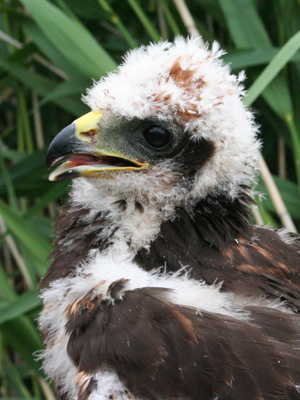
Scottish Raptor Study Group
Monitoring and conserving Scotland's birds of prey
Marsh Harrier

Early Scottish ornithologists regarded the marsh harrier as an uncommon visitor to Scotland. Although occasional breeding had been suspected during the 1930/40s, the species only began to establish itself as a breeding colonist in Perthshire during the late 1980s. The Tay Estuary now hosts a small but regular population of between 3-5 nesting pairs, and chicks have been ringed and wing tagged on an annual basis. A significant milestone was reached in 2004 when the 100th chick was ringed.
It was also in 2004 that the first British marsh harrier from this small Scottish population was fitted with a satellite radio transmitter. This venture was a collaboration between members of the Tayside Raptor Study Group, the Tay Ringing Group and Roy Dennis. This resulted in the first detailed record of the migration route of a young harrier from nest site to wintering area in West Africa. A complete account of the journey can be viewed on the website of the Highland Foundation for Wildlife at www.roydennis.org
Scottish marsh harriers rely solely on reed bed habitats for nesting purposes though chicks from the Tay region have successfully nested in arable crops in England. It has been shown that there is a strong preference for fertile arable farmland adjacent to the breeding site, which clearly reflects the range and abundance of prey species. The variety of prey includes wader and corvid chicks, other small birds, and small mammals. Since the Tay population has become established, breeding has occurred in a number of other areas in Scotland ranging from the far North, through East and Central areas down to the South West, monitoring being carried out by raptor group members and the RSPB.
The population still remains extremely fragile, the reasons for which remain unclear. The increase in breeding during the late nineties has also mirrored the number of migrants being recorded across all regions of Scotland, a possible reflection of stricter control of pesticide use and harsher penalties for persecution. Whilst the limited area of suitable wetland habitat in Scotland may be a factor which restricts expansion in the long term, given a number of apparently suitable sites, there is ample opportunity for colonisation and expansion in the short term. During the breeding season it is also a species which can easily be overlooked.
Harry Bell
References:
Clark, R. (1995). The Marsh Harrier. Hamlyn, London.
Simmons, R.E. (2000). Harriers of the World: Their Behaviour and Ecology. Oxford University Press, UK.
Scottish Raptors•
Honey-Buzzard•
Red Kite•
White-Tailed Eagle•
Marsh Harrier
Hen Harrier•
Goshawk•
Sparrowhawk•
Common Buzzard•
Golden Eagle
Osprey•
Kestrel•
Merlin•
Hobby•
Peregrine Falcon•
Barn Owl
Tawny Owl•
Long-eared Owl•
Short-eared Owl•
Raven